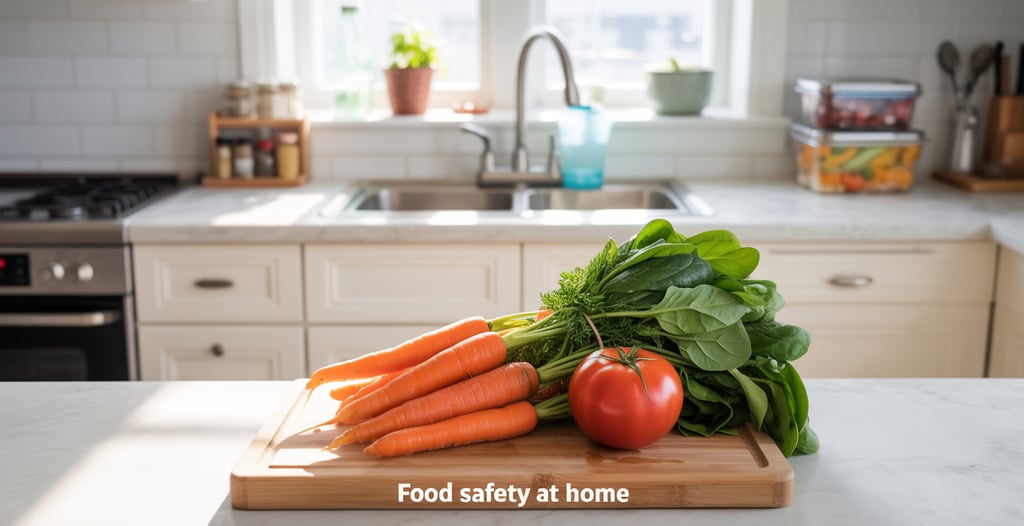The Importance of Food Safety at Home This Season
Food safety at home has never been more important. Around the world, experts warn that with a growing population, changing diets, and complex food supply chains, keeping our meals safe is becoming a growing challenge. And while global systems adapt, one simple truth remains: if it’s not safe, it’s not food. New food trends like plant-based meals, lab-grown products, and global shipping disruptions bring both opportunities and risks, making it essential to stay vigilant. Even though food today is safer than in the past, the risk of contamination and food fraud still exists. That’s why the best protection starts in your own kitchen. To help avoid food poisoning at home this season, follow these four essential steps: Clean, Separate, Cook, Chill.
8/16/20255 min read


The Importance of Food Safety at Home: 4 Essential Steps to Protect Your Family
We often think of food safety as something that happens in restaurants, grocery stores, or food factories, but one of the most common places where foodborne illness occurs is in the home. Every year, millions of people around the world get sick from food prepared in their own kitchens. These illnesses can range from mild stomach upset to severe infections requiring hospitalization and for vulnerable groups such as older adults, young children, pregnant women, and people with weakened immune systems, food poisoning can even be life-threatening.
The good news? Preventing foodborne illness doesn’t require complicated tools or expensive equipment. Instead, it comes down to four simple but powerful steps: Clean, Separate, Cook, and Chill. By following these safe food handling practices every day, you can significantly reduce your family’s risk of getting sick from contaminated food.
Before diving into the steps, let’s quickly understand why food safety at home is so critical. Bacteria, viruses, and parasites are invisible to the naked eye. You can’t see, smell, or taste them, but they can multiply quickly if food is left in unsafe conditions. Something as simple as forgetting to wash your hands after handling raw chicken, or leaving leftovers on the counter for too long, can create the perfect opportunity for harmful microbes to grow. That’s why practicing food safety in the kitchen isn’t optional-it’s essential.
Now, let’s break down the four golden rules of food safety at home.
Step 1: Clean – Stop Bacteria Before They Spread
The first and most important step in food safety is cleanliness. Germs spread easily in the kitchen, and once they contaminate surfaces or utensils, they can quickly move to the food you’re preparing.
Wash Your Hands Properly
Your hands are the number one tool in the kitchen, but they are also one of the most common ways germs spread. Always wash your hands with warm, soapy water for at least 20 seconds before and after handling food, especially raw meat, poultry, seafood, or eggs. Don’t forget to wash again after sneezing, coughing, using the restroom, or touching pets.
Keep Surfaces and Tools Clean
Cutting boards, knives, counters, and dishcloths can all harbour harmful bacteria. To prevent cross-contamination:
Wash utensils, cutting boards, and dishes with hot soapy water after preparing each food item.
Wipe down counters with a disinfectant or hot soapy water before and after cooking.
Replace dishcloths and sponges frequently, as they can quickly become breeding grounds for bacteria. Wash dish towels in the hot cycle of your washing machine.
Rinse Fruits and Vegetables
Even foods that seem clean can carry bacteria, dirt, or pesticide residues. Always rinse fresh produce under running water before eating or cooking it-even if you plan to peel it. For firm produce like carrots or melons, use a clean vegetable brush.
By keeping your kitchen and hands clean, you cut off the first path that harmful microbes use to reach your food.
Step 2: Separate – Prevent Cross-Contamination
One of the easiest ways bacteria spread is when raw food touches ready-to-eat food. This process, known as cross-contamination, is a leading cause of foodborne illness.
At the Grocery Store
Food safety starts before food even enters your home. Place raw meat, poultry, and seafood in separate plastic bags at the store so their juices don’t drip onto fruits, vegetables, or other foods in your cart.
In the Refrigerator
Always store raw meats on the bottom shelf of the refrigerator in a sealed container or plate to catch any leaks. This prevents harmful juices from dripping onto other items. Ready-to-eat foods like salads, fruit, and dairy products should be stored higher up and well away from raw meats.
In the Kitchen
Use one cutting board for raw meat, poultry, and seafood, and another for fruits, vegetables, and bread (the easiest way is to use different colors). If you only have one board, wash it thoroughly with hot soapy water between uses.
Also, never reuse plates or utensils that touched raw food unless they have been properly washed. For example, don’t place grilled chicken back onto the same plate that held it when it was raw.
By keeping foods separated, you reduce the chances that dangerous bacteria will sneak into your meals.
Step 3: Cook – Kill Harmful Germs with Heat
Cooking food to the right temperature is one of the most effective ways to ensure it’s safe to eat. Heat kills harmful bacteria such as Salmonella, E. coli, and Listeria that may be lurking in raw or undercooked foods.
Use a Food Thermometer
Don’t rely on guesswork or appearance-foods can look cooked on the outside but still be raw inside. The only way to know if food has reached a safe internal temperature is with a food thermometer. Insert it into the thickest part of the food, avoiding bone or fat, to get an accurate reading.
Safe Cooking Temperatures
Here are a few general guidelines:
Poultry (chicken, turkey): 74°C (165°F)
Ground meats: 71°C (160°F)
Steaks, roasts, fish: 63°C (145°F)
Leftovers and casseroles: 74°C (165°F)
Keep Food Hot
If food isn’t eaten right away, keep it hot at 60°C (140°F) or above until served. Use warming trays, slow cookers, or an oven set on low. When reheating leftovers, always bring them to at least 74°C (165°F). Soups, sauces, and gravies should be reheated to a rolling boil to destroy any bacteria.
Cooking food properly gives you peace of mind that what you’re serving is safe and delicious.
Step 4: Chill – Keep It Cold, Keep It Safe
Bacteria multiply fastest in the “danger zone” between 4°C (40°F) and 60°C (140°F). Chilling food promptly and correctly is one of the simplest yet most effective ways to prevent foodborne illness.
Refrigerate Promptly
Refrigerate or freeze perishable foods within two hours of cooking or purchasing them (within one hour if the temperature is above 32°C / 90°F). Don’t leave leftovers sitting on the counter for long periods.
Organize Your Refrigerator
Keep your refrigerator set at 4°C (40°F) or lower, and your freezer at -18°C (0°F). Use a fridge thermometer to monitor temperatures. Store hot foods in shallow containers so they cool quickly, and don’t overcrowd the fridge so air can circulate properly.
Store Leftovers Safely
Refrigerate leftovers as soon as possible and consume them within 48 hours. Reheat them thoroughly before eating. When thawing frozen food, do so in the refrigerator, under cold running water, or in the microwave -not on the counter, where bacteria can multiply quickly.
Proper chilling ensures that bacteria never get the chance to grow to dangerous levels.
Special Considerations for Older Adults and Vulnerable Groups
While food safety is important for everyone, certain groups are at greater risk of serious illness from foodborne pathogens. Older adults, young children, pregnant women, and people with weakened immune systems should take extra care to follow these steps. For example, they should avoid high-risk foods like unpasteurized dairy, raw sprouts, or undercooked meats. Simple precautions can make a big difference in protecting their health.
Food safety at home is not just about preventing foodborne illness - it’s about creating peace of mind and protecting the people you love. By consistently practicing the four steps - Clean, Separate, Cook, and Chill-you build a strong defence against harmful bacteria, viruses, and parasites.
Remember, food poisoning doesn’t happen only in restaurants or from processed food recalls. It can just as easily happen in your own kitchen if you don’t handle food properly. But with awareness, preparation, and good habits, you can make sure every meal you serve is safe, healthy, and enjoyable.
So next time you cook at home, think of these four steps as your recipe for safety. Small, mindful actions like washing your hands, using a food thermometer, and refrigerating leftovers promptly can make a huge difference. Protect your family, prevent illness, and enjoy your food with confidence.
Join us on Pinterest
letstalk@lorybs.com
© 2025. All rights reserved.
